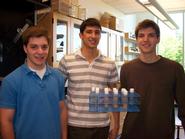
Although the brain of a fruit fly or a honey bee might seem too small to be very active, chemicals do rage underneath the surface tissue. For example, octopamine is a neurotransmitter that plays a major role in learning and memory processes of Drosophila melanogaster (common fruit fly) and Apis mellifera (honey bee).
Octopamine synthesis, however, requires tyramine β-hydroxylase (Tβh), an enzyme important to the development of invertebrates. This summer, Andrew Brodsky ’11, Jonathan Chaponis ’10, and Stephen Chaponis ’10 are researching TβhR, a gene with structural similarities to Tβh. With Associate Professor of Biology Herman Lehman, they will investigate the possible function of TβhR.
Tyramine acts as a precursor to octopamine, and Tβh is the enzyme that catalyzes the hydroxylation of tyramine to octopamine. Hydroxylation is a chemical process that introduces one or more hydroxyl groups (-OH) into a compound, thereby oxidizing it. But they already know about Tβh’s performance in these organisms – they want to learn more about TβhR. To do this, they will carry out a process known as in situ hybridization (ISH), in which they will synthesize an RNA strand, or “probe,” from a specific DNA sequence that is complementary to TβhR’s coding mRNA. The probe hybridizes, or pairs, with a target sequence of mRNA at an elevated temperature. After the students accomplish this task, they will introduce an antibody that will attach to the probe paired with TβhR’s mRNA sequence. Finally, a color development substrate will be added to attach to the antibody. This will alert the students as to where the gene transcript for TβhR can be found. Knowing the location of TβhR can help them determine its worth and what it does for the production of octopamine.
While most of their project consists of working together on the in situ hybridization, they each have responsibilities outside the realm of their collaborative work. Jon Chaponis will examine the location of TBhR in the brain and upper digestive tract as well as in the larvae of fruit flies. Andrew Brodsky will spend time dissecting honey bee’s brain and using ISH to scrutinize micron-thick cross sections. Stephen’s goal is to devise a method using liquid chromatography-mass spectrometry, an analytical chemistry technique that will enable him to quantify octopamine and tyramine in Drosophila brains. This technique would be especially useful for determining the amount of octopamine in brains with varying amounts of TβhR.
Brodsky, who is considering dental school after Hamilton, says that he has always been a “science-y” kid and feels that biology is so much more than just biology – usually it embraces chemistry and physics as well. Stephen Chaponis suggests that chemistry also integrates psychology. He and his brother, Jon, plan to attend medical school.
Octopamine synthesis, however, requires tyramine β-hydroxylase (Tβh), an enzyme important to the development of invertebrates. This summer, Andrew Brodsky ’11, Jonathan Chaponis ’10, and Stephen Chaponis ’10 are researching TβhR, a gene with structural similarities to Tβh. With Associate Professor of Biology Herman Lehman, they will investigate the possible function of TβhR.
Tyramine acts as a precursor to octopamine, and Tβh is the enzyme that catalyzes the hydroxylation of tyramine to octopamine. Hydroxylation is a chemical process that introduces one or more hydroxyl groups (-OH) into a compound, thereby oxidizing it. But they already know about Tβh’s performance in these organisms – they want to learn more about TβhR. To do this, they will carry out a process known as in situ hybridization (ISH), in which they will synthesize an RNA strand, or “probe,” from a specific DNA sequence that is complementary to TβhR’s coding mRNA. The probe hybridizes, or pairs, with a target sequence of mRNA at an elevated temperature. After the students accomplish this task, they will introduce an antibody that will attach to the probe paired with TβhR’s mRNA sequence. Finally, a color development substrate will be added to attach to the antibody. This will alert the students as to where the gene transcript for TβhR can be found. Knowing the location of TβhR can help them determine its worth and what it does for the production of octopamine.
While most of their project consists of working together on the in situ hybridization, they each have responsibilities outside the realm of their collaborative work. Jon Chaponis will examine the location of TBhR in the brain and upper digestive tract as well as in the larvae of fruit flies. Andrew Brodsky will spend time dissecting honey bee’s brain and using ISH to scrutinize micron-thick cross sections. Stephen’s goal is to devise a method using liquid chromatography-mass spectrometry, an analytical chemistry technique that will enable him to quantify octopamine and tyramine in Drosophila brains. This technique would be especially useful for determining the amount of octopamine in brains with varying amounts of TβhR.
Brodsky, who is considering dental school after Hamilton, says that he has always been a “science-y” kid and feels that biology is so much more than just biology – usually it embraces chemistry and physics as well. Stephen Chaponis suggests that chemistry also integrates psychology. He and his brother, Jon, plan to attend medical school.
